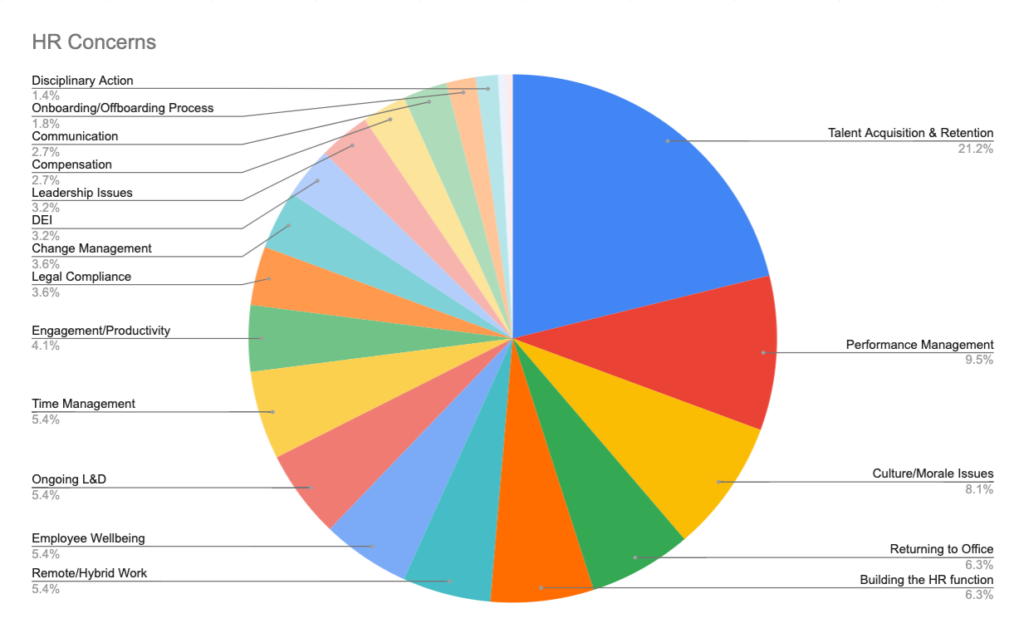What Keeps Human Resources Professionals Awake At Night?
We posted this question as an icebreaker in our HR Superstars community, because we figured if anyone is going to share vulnerably immediately, it’s going to be Human Resources Professionals (aka People Ops):
What one aspect of your HR role has kept you up at night in the last week?
After reading through the myriad responses, I am even more in awe of HR leaders (and I used to be a Chief People Officer!) Here’s what I learned…

HR does it all!
We received over 220 total responses, broken down into nearly forty categories! Some of the concerns we saw were implementing performance management, career development, returning to the office, competencies and skills matrices, compensation, ongoing learning and development, and communication with the C-suite.
Here’s a thread that offers more clarity into an HR challenge (disciplinary action):
Post: I can’t give information, but when a valued employee really messes up, nothing illegal or immoral, it is difficult to decide how to address and repair the damage and how to move forward. Sometimes, firing isn’t the answer.
Response: Thanks for sharing, I feel you on this. I think that most of the time, firing is not the answer, especially because people talk and then the org or team gets a reputation that it’s not safe to make mistakes. I’m curious how the expectations and agreements were set up from the beginning and if there were any obstacles to the employee speaking up and asking for help?
And another that discussed both cultural issues and employee off-boarding:
Post: I’ve been doing exit interviews, and while most of them have been easy and joyful, the harder ones are the ones that stick with me, the employees who felt that they’ve been wronged and hurt by our organization. I keep thinking about how what I see from my perspective is sometimes so far removed from their day-to-day experience in the organization. I didn’t even know some of the things that have been unearthed in these interviews had been happening. It’s something I hope to plan to rectify moving forward.
Response: I commend you for prioritizing proactive feedback to reduce the number of exit interviews you get in the first place.I understand the struggle of obtaining solid participation numbers when it comes to feedback. Creating a culture of continuous feedback is a company-wide effort that needs to be initiated and backed by leadership. Sending you a DM. 🙂
What really keeps Human Resources professionals up at night?
To make sense of the data, we consolidated the forty themes and charted the data below. These are the top seven concerns of HR professionals:
- Talent Acquisition and Retention
- Performance Management
- Culture and Morale Issues
- Returning To Office (Health & Safety)
- Building the HR Function
- Remote/Hybrid Work
- Employee Wellbeing

Talent Acquisition & Retention
No surprise here, as this was an ongoing concern even before the pandemic. Now it seems that with remote work becoming more normalized, employees are moving to parts of the country that have a significantly higher quality of life at a fraction of the cost of living. One example is The Great Exodus from regions like Northern California:
During the fourth quarter of 2020, roughly 114,600 people left the Bay Area, up 29.7 percent from the same period in 2019.
Mercury News
There’s also The Great Resignation, where 40 percent of people are thinking of leaving their jobs and a good percentage of folks are actually doing it. This is related to increased access to a global talent pool, but also to unexpected factors like burnout. In a recent, community fireside chat with TrueCar CEO, John Foster, John shared that burnout has a lot to do with control (click the link directly above and watch at 39:26):
When people are talking about this Great Resignation… that’s sometimes a break because you have control. You can choose to say, ‘I’m not going to do this anymore. I can choose to go somewhere else’.
John Foster, CHRO of TrueCar
Despite how the media frames these phenomena, for people teams, there is nothing great about exodus or resignation. The stakes have never been higher to build a strong employer brand, create opportunities for internal advancement, and build a robust culture where people can thrive.
Remote/Hybrid Work
This one is not a surprise either and, as I’ve shared, is related to that top concern of talent acquisition and retention. We even made this our June theme in the community with round-tables on dynamic work and community members sharing their reopening office plans.
What we saw in 2020, was that many organizations who were forced to go remote in order to survive were dealing with trust, communication, and engagement. Technology helped to ease these struggles, but that alone was not sufficient.
As offices reopen and hybrid work is becoming the new, new normal, we are seeing a whole slew of emerging issues that tech alone can’t solve. Creating competition between the here’s vs the there’s, uneven odds of getting promoted, and cultural dilution, to name a few. Since this way of working is here to stay, we are seeing a huge opportunity for innovation in the field of HR and the need for strategic initiatives.
Performance Management
Many of these comments had to do with successfully rolling out performance management software or the implementation of process. Issues like performance reviews, engagement, culture and morale, psychological safety, and team communication all fall into this category.
Community members also voiced concerns about executive buy-in. Here is the response and advice that was shared:
Executive sponsorship and involvement is critical for success in any company-wide software roll out. I would say the “must do” prior to rolling out is to get executive buy-in, including a company-wide announcement by your executive sponsor to explain why you are doing this, to set expectations around key dates, and to ask for feedback/questions.
The shift to strategic HR
Many Human Resources professionals are bogged down in administrative tasks like payroll and benefits, they struggle to get ahead of employee attrition, and they are not seen as true partners to the rest of leadership. What’s needed is to get ahead of these issues by becoming strategic business partners and planning a people strategy to ensure a strong employer brand and high performance and engagement.
But one of the main concerns we hear from HR leaders is that they are too busy to be strategic. When two-hundred people people say that forty distinct concerns related to their roles keep them up at night, that’s a pretty strong indicator that this issue is real.
We created the HR Superstars community to help with this concern; to elevate HR to a strategic business function. Because that’s what HR is. They are not ancillary. They are most valuable when they lay out and execute the frameworks for how to pair people performance with business performance.
To be a part of this movement, please join us in the HR Superstars Community! We host fireside chats with successful, progressive people leaders from large organizations. You can access actionable resources like webinars and playbooks from academics and industry experts. Best of all, you will have a place where you can connect, grow your networks, and get answers from people who have been there.
Perhaps the next time someone asks you what is keeping you up at night, you can respond with,”nothing at all”.
Photo by Alexandra Gorn on Unsplash




